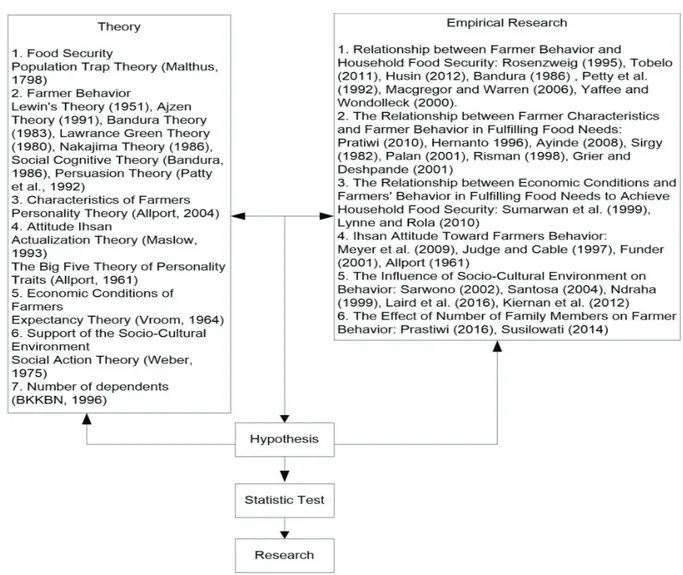Print ISSN: 2288-4637 / Online ISSN 2288-4645 doi:10.13106/jafeb.2021.vol8.no2.1225
Analysis of Farmer Behavior Based on Farmer Characteristics, Economic Conditions, and Number of Family Members
Hamidah HENDRAINI
1, Teguh SOEDARTO
2Received: August 05, 2020 Revised: January 05, 2021 Accepted: January 15, 2021
Abstract
This study aims to analyze the influence of farmer characteristics, Ihsan attitude, economic conditions, and socio-cultural environmental support, and the number of family members on farmer behavior in meeting food needs in realizing household food security, with the role of the government as a moderator. This study is about the relationship between farmer behavior and their household food security. This research uses a quantitative research method involving 337 farmers from three villages located in three different sub-districts, namely Alang-alang village, Tragah sub-district, Mrecah village, Tanah Merah sub-district, and finally Gangsean village, Sepulu sub-district. The quantitative analysis approach consists of formulating problems, compiling models, obtaining data, finding solutions, testing solutions, analyzing results, and interpreting results. From the 7 hypotheses that were built, it was identified that there was 1 hypothesis that was not significant, namely the influence of the support of the socio-cultural environment on farmer behavior to meet the food needs of farmers’
households. The attitude that is identified is still very rarely used in the context of agricultural human resources and at the same time is an inherent character of Madurese farmers which is an interesting part for researchers to study more deeply and become new or authentic in this research.
Keywords: Farmer Behavior, Household Food Security, Food JEL Classification Code: Q18, Q12, Q19
farmers with low income are unable to buy food according to basic nutritional needs, lack of control or land ownership is also the cause of unavailability of foodstuff to meet the needs of farmer families, low income and the absence of ownership or control of agricultural land is the main cause of the low food security of farming families.
The geographic condition of the region shows that the Bangkalan Regency area has differences in physical, topography and geo-socio-economic aspects. This condition also affects the distribution of existing regional resources. In addition, Bangkalan Regency has a very strategic location because it is the entrance and exit (access) to goods and services on Madura Island. This condition is certainly a challenge that must be faced by the Regional Government of Bangkalan Regency as an area of guidance and development to realize food welfare for farmers. The geographical conditions of the area indicate that Bangkalan Regency has physical, topographical and socio- economic characteristics. This condition affects the distribution of existing regional resources.
Problems of farmers and their households are complex and interesting to study, some of them have been an attempt
1
First Author and Corresponding Author. Lecturer, Faculty of Agriculture, University of Pembangunan Nasional “Veteran” East Java, Indonesia [Postal Address: Rungkut Madya No. 1, Gunung Anyar, Surabaya, East Java, 60294, Indonesia]
Email: rini.upn.jp@gmail.com
2
Lecturer, Faculty of Agriculture, University of Pembangunan Nasional “Veteran” East Java, Indonesia.
Email: teguhs.upn.jp@gmail.com
© Copyright: The Author(s)
This is an Open Access article distributed under the terms of the Creative Commons Attribution Non-Commercial License (https://creativecommons.org/licenses/by-nc/4.0/) which permits unrestricted non-commercial use, distribution, and reproduction in any medium, provided the original work is properly cited.
